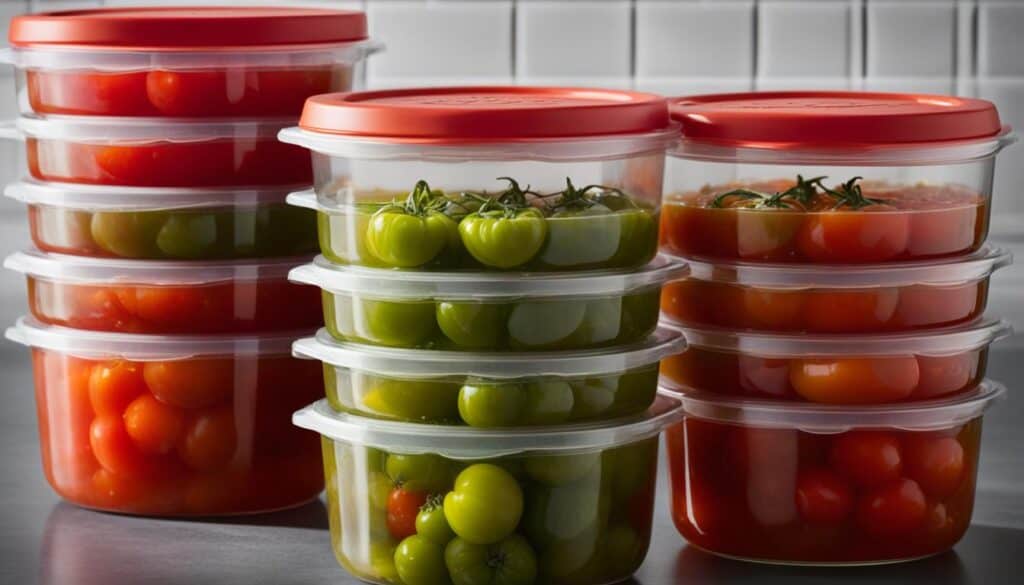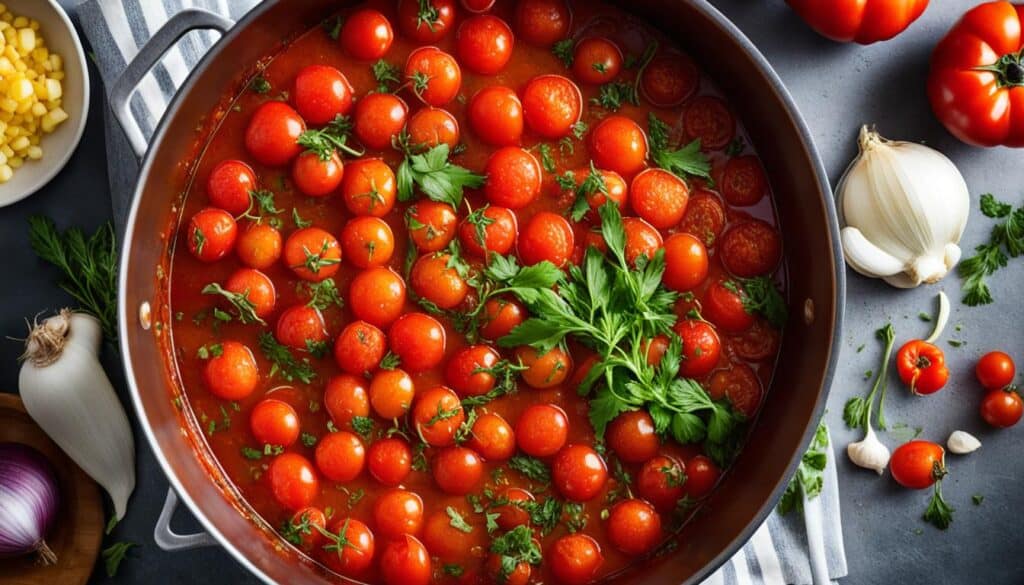Did you know that stewed tomatoes are not only delicious but also incredibly versatile? Whether you’re a fan of tomato stews or looking for creative ways to incorporate tomatoes into your dishes, stewed tomatoes can elevate your recipes to new levels of flavor.
From soups and stews to pasta sauces and more, stewed tomatoes add a rich and savory element that tantalizes the taste buds. Whether you use fresh tomatoes or canned varieties, the possibilities are endless when it comes to creating mouthwatering tomato dishes.
In this article, I will share some easy-to-follow tips and creative ideas for making delicious stewed tomatoes. Get ready to take your tomato recipes to the next level!
Key Takeaways:
- Stewed tomatoes are versatile and can be enjoyed in a variety of dishes.
- Both fresh and canned tomatoes can be used to make delicious stewed tomatoes.
- Stewed tomatoes add richness and depth to soups, stews, and pasta sauces.
- Consider adding extra flavors like celery, onions, and bell peppers to your stewed tomatoes.
- Stewed tomatoes can be stored in the fridge or freezer for future use.
How to Make Basic Stewed Tomatoes
When it comes to cooking basic stewed tomatoes, a few simple ingredients can go a long way. With fresh tomatoes, salt, pepper, butter, and sugar, you can create a flavorful and versatile dish that can be enjoyed on its own or used as a base in various recipes. Here’s how to make basic stewed tomatoes:
- Start by preparing the tomatoes. Peel them and cut them into chunks.
- Heat a saucepan over medium heat and add the tomato chunks. Cook them until they release their juices.
- Once the tomatoes have released their juices, reduce the heat to low and continue cooking until you reach your desired consistency.
- Add seasonings like salt, pepper, and a small amount of sugar to enhance the natural flavors of the tomatoes. Adjust the seasonings to taste.
- Continue cooking the stewed tomatoes for a few more minutes to allow the flavors to meld together.
- Once the stewed tomatoes are ready, serve them as is, or with toppings like croutons for added texture and crunch.
So there you have it! A simple and delicious recipe for basic stewed tomatoes. Whether you enjoy them as a standalone dish or use them as a base in other recipes, these stewed tomatoes are sure to add a burst of flavor to your meals.
Stay tuned for more tips and ideas on how to make the most out of your stewed tomatoes!
Tips for Perfect Stewed Tomatoes
When it comes to creating the perfect stewed tomatoes, the choice of tomatoes plays a crucial role. For the most flavorful and sweet stewed tomatoes, I highly recommend using ripe tomatoes from your garden or the farmers market. These tomatoes are typically picked at peak ripeness, ensuring that they have the best taste and texture.
Whether you’re enjoying stewed tomatoes on their own or using them as a base in dishes like stews, soups, and chilis, the quality of the tomatoes will significantly impact the final result. Ripe garden tomatoes or those sourced from the farmers market are known for their superior flavor and juiciness.
For an extra touch of texture and flavor, consider topping your stewed tomatoes with crispy croutons. The combination of the soft tomatoes and crunchy croutons creates an enjoyable contrast that enhances the overall eating experience.
“Using ripe garden tomatoes or those from the farmers market will elevate the flavor of your stewed tomatoes to a whole new level.”
So, the next time you want to make a batch of stewed tomatoes, be sure to choose ripe tomatoes, preferably from your garden or the farmers market. Don’t forget to add some crunchy croutons on top for that satisfying bite!
| Key Ingredients | Benefits |
|---|---|
| Ripe tomatoes | Intense flavor and sweetness |
| Garden tomatoes | Freshness and juiciness |
| Farmers market tomatoes | High quality and variety |
| Croutons | Added crunch and texture |
Alternative Methods for Peeling Tomatoes
Peeling tomatoes can be a time-consuming process, but there are alternative methods to make it easier.
1. Use a sharp knife:
One method for peeling tomatoes is to use a sharp knife. Start by making a small X on the bottom of each tomato. This helps to loosen the skin and makes it easier to remove. Then, gently peel away the skin from each tomato, working from the X towards the stem end. Take your time and be careful not to cut yourself.
2. Blanching the tomatoes:
Another method for peeling tomatoes is blanching. Begin by bringing a pot of water to a boil. Carefully drop the tomatoes into the boiling water and let them cook for about one minute. This blanching process helps to loosen the skin. Next, using a slotted spoon, transfer the tomatoes to a bowl of ice water to cool them quickly. Once the tomatoes are cool, the skin should easily slip off when gently rubbed or peeled.
These alternative methods can save you time and frustration when it comes to peeling tomatoes. Choose the method that works best for you and enjoy the process of preparing delicious meals with perfectly peeled tomatoes!
“I find that using a sharp knife is the quickest and most precise way to peel tomatoes. By making a small X on the bottom, the skin easily loosens, allowing for a smooth and efficient peeling process. Alternatively, blanching the tomatoes in boiling water before transferring them to ice water is another effective method. The rapid temperature change causes the skin to contract and makes peeling a breeze.”
Flavor Variations for Stewed Tomatoes

To add some extra flavor to your stewed tomatoes, consider sautéing finely chopped celery, onions, and bell peppers. These vegetables will add a zestier and more flavorful dimension to the dish. For some added heat, you can also incorporate ingredients like Tabasco sauce or red pepper flakes.
Adding celery, onions, and bell peppers to your stewed tomatoes not only enhances their taste but also introduces a satisfying crunch. The combination of these aromatic vegetables provides a harmonious balance of flavors that complement the natural sweetness of the tomatoes.
“The addition of celery, onions, and bell peppers brings depth and complexity to the dish, making it even more enjoyable for your palate.” – Chef Julia Smith
Tabasco Sauce and Red Pepper Flakes
If you’re looking to spice things up, a dash of Tabasco sauce or a sprinkle of red pepper flakes will infuse your stewed tomatoes with just the right amount of heat. These fiery ingredients bring a touch of excitement and intensity to the dish, tantalizing your taste buds with their bold flavors.
Keep in mind that Tabasco sauce and red pepper flakes should be added sparingly at first, as their spiciness can vary. Taste as you go, adjusting the amount according to your preference for heat. Remember, a little goes a long way, so start with a small amount and gradually increase to achieve your desired level of spiciness.
Storage and Freezing Tips for Stewed Tomatoes

When it comes to storing your delicious stewed tomatoes, it’s important to follow a few simple guidelines to maintain their freshness and flavor. Here are some handy tips for storing and freezing stewed tomatoes:
Storing Stewed Tomatoes in the Fridge
If you plan to consume your stewed tomatoes within a few days, storing them in an airtight container in the fridge is the way to go. This will keep them fresh and prevent any cross-contamination with other foods. Remember to use a container that seals tightly to maintain the flavor and prevent any odors from seeping in.
Here’s a simple step-by-step guide:
- Allow the stewed tomatoes to cool down completely before transferring them to a container.
- Place the stewed tomatoes in an airtight container, ensuring that there is no excess air inside.
- Label the container with the date to keep track of its freshness.
- Store the container in the fridge, preferably on a shelf where it won’t get disturbed.
By storing your stewed tomatoes properly in the fridge, you can enjoy their delicious flavor for up to five days.
Freezing Stewed Tomatoes
If you have a surplus of stewed tomatoes or want to extend their shelf life, freezing is a great option. Follow these steps to freeze your stewed tomatoes:
- Allow the stewed tomatoes to cool down completely before freezing them. This prevents the formation of ice crystals and ensures the best texture.
- Transfer the stewed tomatoes to a freezer-safe container, leaving some headspace to allow for expansion.
- Alternatively, you can use zip-top freezer bags, squeezing out any excess air before sealing them.
- Label the container or bag with the date and contents.
- Place the stewed tomatoes in the freezer, ideally in a single layer to promote faster freezing.
Properly frozen stewed tomatoes can last for up to three months without compromising their taste and quality.
When you’re ready to use your frozen stewed tomatoes, simply thaw them overnight in the refrigerator or defrost them in the microwave. They’re perfect for adding flavor to soups, stews, pasta sauces, and more.
Canning Stewed Tomatoes
Canning is another wonderful way to preserve stewed tomatoes for an even longer period. By following proper sterilization and canning procedures, you can enjoy your stewed tomatoes well beyond the fresh season.
Here’s an essential step:
When canning stewed tomatoes, it’s important to add bottled lemon juice to maintain the right level of acidity and safeguard against potential bacterial growth.
Here’s a helpful tip: make sure to consult reliable canning resources or experts for detailed instructions on the sterilization process and proper canning techniques to ensure food safety.
Summary
Storing and freezing stewed tomatoes allows you to enjoy their delicious flavor at any time. Whether you choose to store them in an airtight container in the fridge, freeze them for longer shelf life, or can them for even more extended preservation, these tips and methods will help keep your stewed tomatoes fresh and full of flavor.
Canned Stewed Tomatoes vs. Other Canned Tomato Varieties
When it comes to canned tomatoes, there are various options available to suit different recipes and tastes. From whole peeled and diced to crushed and tomato sauce, each variety has its own unique characteristics. In this section, we will explore the differences between canned stewed tomatoes and other popular canned tomato varieties.
Stewed Tomatoes
Stewed tomatoes are cooked but not pureed, often with added seasoning for extra flavor. They have a chunkier texture compared to other canned tomato varieties, making them a great choice for recipes that require pieces of tomato to be visible.
Whole Peeled Tomatoes
Whole peeled tomatoes are exactly what they sound like – whole tomatoes that have been peeled and packed in their natural juices. They are not cooked, which gives them a firmer texture compared to stewed tomatoes.
Diced Tomatoes
Diced tomatoes are typically made by chopping whole tomatoes into small, uniform pieces. They provide a balance between texture and juiciness, making them versatile for a wide range of recipes.
Crushed Tomatoes
Crushed tomatoes are made by blending whole tomatoes into a coarse puree. They have a texture similar to stewed tomatoes and can be a good substitute in recipes that call for stewed tomatoes. However, it’s important to note that crushed tomatoes are not cooked, so consider briefly cooking them if using as a replacement.
Tomato Sauce
Tomato sauce is a smooth, cooked puree made from tomatoes. It is often seasoned with herbs and spices, making it a convenient choice for pasta sauces and as a base for other dishes.
Comparison Table
| Canned Tomato Variety | Texture | Usage |
|---|---|---|
| Stewed Tomatoes | Chunky | Recipes requiring visible tomato pieces |
| Whole Peeled Tomatoes | Firm | Versatile for recipes |
| Diced Tomatoes | Medium texture | Wide range of recipes |
| Crushed Tomatoes | Coarse puree | Can be used as a substitute for stewed tomatoes |
| Tomato Sauce | Smooth puree | Pasta sauces, bases for other dishes |
As you can see, each canned tomato variety offers its own unique qualities. While stewed tomatoes are perfect for recipes that require visible tomato pieces, crushed tomatoes can be a suitable substitute. Consider the texture and cooking requirements of each variety when deciding which one to use in your recipes.
Homemade Stewed Tomatoes Recipe

Making homemade stewed tomatoes allows you to savor the vibrant flavors of fresh tomatoes complemented by a medley of seasonings. This versatile recipe typically includes fresh tomatoes, garlic, bell peppers, and a blend of dried spices.
To create this mouthwatering dish, start by peeling the tomatoes and chopping them into chunks. Then, sauté onions and bell peppers in a pot until they turn tender and fragrant. Add minced garlic and the selection of dried spices, such as oregano, basil, and thyme, to enhance the tomato sauce’s savory notes.
Tip: Try incorporating dried red pepper flakes for a subtle kick of heat.
Next, gently stir in the peeled tomatoes and allow the mixture to simmer over low heat. As the tomatoes cook down, their natural juices blend with the other ingredients, creating a rich, thick sauce bursting with flavors.
This homemade stewed tomatoes recipe can be served as a standalone side dish, accompanied by crusty bread to soak up the delectable sauce. Alternatively, use it as a base for pasta sauces, soups, stews, or chili, enhancing their taste profiles with its delightful essence.
Explore the endless culinary possibilities with this homemade stewed tomatoes recipe, injecting a burst of flavor into your favorite dishes.
Balsamic Stewed Tomatoes Recipe
Balsamic stewed tomatoes are a simple and flavorful side dish that requires minimal prep work. This recipe uses grape tomatoes, balsamic vinegar, sugar, thyme sprigs, and kosher salt. It’s a perfect way to enhance the natural sweetness of grape tomatoes while adding a tangy balsamic twist. Here’s how to make it:
Ingredients:
- 2 cups grape tomatoes
- 2 tablespoons balsamic vinegar
- 1 tablespoon sugar
- 2-3 thyme sprigs
- Pinch of kosher salt
Instructions:
- In a saucepan, combine the grape tomatoes, balsamic vinegar, sugar, thyme sprigs, and a pinch of kosher salt.
- Place the saucepan over medium heat and bring the mixture to a simmer.
- Reduce the heat to low and let the tomatoes cook for about 15-20 minutes, or until they become plump and start to burst.
- Stir occasionally to prevent sticking and to evenly distribute the flavors.
- Remove the pan from the heat and let it cool slightly before serving.
These balsamic stewed tomatoes are bursting with flavor! The combination of the sweet grape tomatoes, tangy balsamic vinegar, and fragrant thyme creates a taste sensation that will impress your guests. The tomatoes will become tender and juicy, while the balsamic vinegar reduces and forms a thick, syrupy sauce.
Enjoy these balsamic stewed tomatoes as a side dish with grilled chicken, steak, or seafood. You can also serve them over toasted bread as a bruschetta topping or add them to pasta dishes for an extra burst of flavor. Their versatility makes them a great addition to any meal!
Tips for Making Balsamic Stewed Tomatoes
When it comes to making balsamic stewed tomatoes, there are a few tips that can help you achieve the best results. First, it is recommended to use a cheaper balsamic vinegar rather than an expensive aged one. While the flavor may not be as complex, the vinegar will still reduce and create a deliciously syrupy sauce as it cooks with the tomatoes.
To enhance the flavors of the balsamic stewed tomatoes, consider adding a bit of sugar and salt. These ingredients will help balance the acidity of the tomatoes and create a more well-rounded taste. The sugar will also contribute to a thicker and more syrupy consistency, giving your dish that perfect texture.
One important tip to keep in mind is to remove the tomatoes from heat as soon as the sauce reaches your desired thickness. This will prevent overcooking and ensure that the tomatoes retain their bursting texture. Remember, the key to a successful balsamic reduction is finding the right balance between sweet and tangy, so be sure to taste and adjust the flavors as needed.
Try this delicious recipe for balsamic stewed tomatoes:
| Ingredients | Quantity |
|---|---|
| Grape tomatoes | 2 cups |
| Cheap balsamic vinegar | 1/4 cup |
| Sugar | 1 tablespoon |
| Thyme sprigs | 2 |
| Kosher salt | 1/4 teaspoon |
1. In a saucepan, combine the grape tomatoes, cheap balsamic vinegar, sugar, thyme sprigs, and kosher salt.
2. Cook over medium heat until the mixture comes to a simmer. Reduce the heat to low and let it simmer for about 15-20 minutes, or until the tomatoes burst and the sauce thickens.
3. Remove from heat and let the balsamic stewed tomatoes cool slightly before serving.
These balsamic stewed tomatoes are a savory and tangy side dish that pairs well with grilled chicken, steak, or seafood. The burst tomatoes and the rich balsamic reduction create a delicious combination of flavors that will impress your taste buds.
Conclusion
Stewed tomatoes are a delicious and versatile ingredient that can elevate any dish to new levels of flavor. Whether you’re preparing a basic recipe or experimenting with different flavors and variations, the richness and depth of stewed tomatoes will delight your taste buds. From simple sides to pasta sauces and soups, there are endless possibilities for incorporating stewed tomatoes into your cooking repertoire.
By following the tips and ideas shared in this article, you can create flavorful dishes that showcase the deliciousness of stewed tomatoes. Whether you’re enjoying them as a standalone dish or using them as a base for your favorite recipes, stewed tomatoes will add a burst of freshness and complexity to every bite.
So, next time you’re in the kitchen, don’t forget to reach for those stewed tomatoes. Explore the world of tomato recipes and discover the incredible flavors that await. Get creative, experiment with new ingredients and techniques, and let stewed tomatoes take your culinary creations to a whole new level of deliciousness. Happy cooking!





Leave a Reply